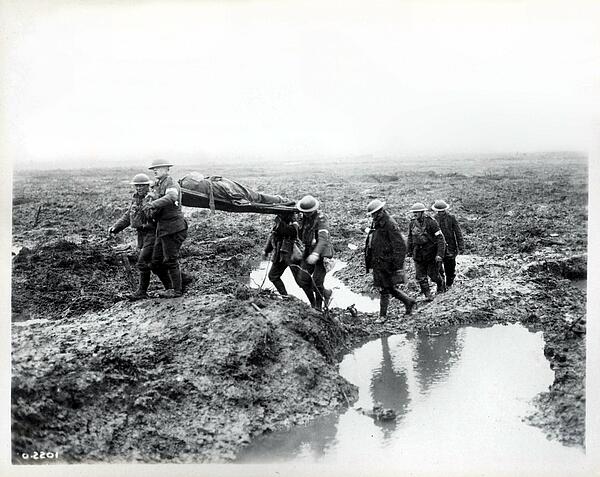The Battle of Passchendaele
The Battle of Passchendaele, sometimes known as the Third Battle of Ypres, was fought in July 1917 and was referred by many of the soldiers as the ‘Battle of Mud’.
Sir Douglas Haig ordered the Battle of Passchendaele as part of his plan to break through Flanders. His main aim was to reach the coast of Belgium and destroy the German submarine pens - Admiral Jellicoe had confirmed that the German submarines had been destroying merchant ships and could cause a serious problem if this continued.
This plan was not initially agreed to by Prime Minister David Lloyd George, but as no other plan was produced he was forced to agree.

On 18th July 1917, the Allies launched a heavy artillery barrage on the German lines that lasted for ten days. More than four thousands shells were launched from three thousands artillery guns and the German army was weakened. However, the barrage removed any opportunity for a surprise infantry attack, which predictably began on 31st July.
The assault was led by Sir Hubert Gough’s fifth Army, which was supported by the French First Army led by Anthoine and the Second Army led by Sir Herbert Plumer.
As had occurred in the Somme, the Germans were fully prepared for the attack and only small gains were made by the Allies. However, the whole battle altered when, in early August, the whole area was saturated with the heaviest rainfall the region had seen for thirty years.
The area around Flanders effectively became a swamp. Tanks got stuck, infantry found movement very difficult, and the drainage systems - destroyed in many places by the artillery barrage - only made the issue worse. Shell craters also filled with water so they couldn’t be used for hiding while men crossed the fields.
Despite this, Haig blamed the lack of progress on Gough, and decided to move Gough and his men to a different front so Plumer could taken charge. Using different tactics to Gough, Plumer sought only small, defendable gains rather than a single large sweep.
This resulted in a series of small battles taking place within Flanders between September and October 1917, including the Battle of Menin Road Bridge, the Battle of Polygon Wood and the Battle of Broodseinde.
Thankfully for Plumer, these battles started to offer the Allies an advantage in the area east of Ypres and Haig - pleased with the progress - was convinced the Germans were close to breaking point.
Haig ordered that the offensive continued to Passchendaele Ridge and two battles took place between 9th and 12th October - Poelcappelle and the First Battle of Passchendaele.
At this stage, the Germans had moved many of their troops from the Eastern Front to the Western Front, specifically to Passchendaele Ridge, to boost numbers. The Germans also employed the tactic of using mustard gas, which prevented the Allies form breaking through to Passchendaele.
However, Haig refused to give in and in late October three further Allied attacks were made on the ridge. On 6th November, the Allies took Passchendaele village and Haig finally decided to call off the attack.
However, the Third Battle of Ypres had been incredibly costly, gaining just a few kilometres for the Allies but costing 310,000 men. The Germans also lost 260,000 men, making it a bloody battle for both sides.
Haig was criticised for failing to change his plans in light of the weather and the fact that the attack was clearly not going to succeed.
However, others came to his defence, stating:
- Haig could not have known that the weather would have played such a major part in the battle.
- The input of the newly arrived German troops from the Eastern Front was not part of Haig's planning and nor could it have been.
- The dangers of German submarine activity had to be eliminated whatever the risk.
- A British success would have gone someway to improving the morale of the French army that had mutinied in that year - an ally supporting an ally.
- Haig argued that any German loss of men was of greater importance than British loss as the Allies could sustain more losses as America had joined the war by the end of Passchendaele
MLA Citation/Reference
"The Battle of Passchendaele". HistoryLearning.com. 2025. Web.
